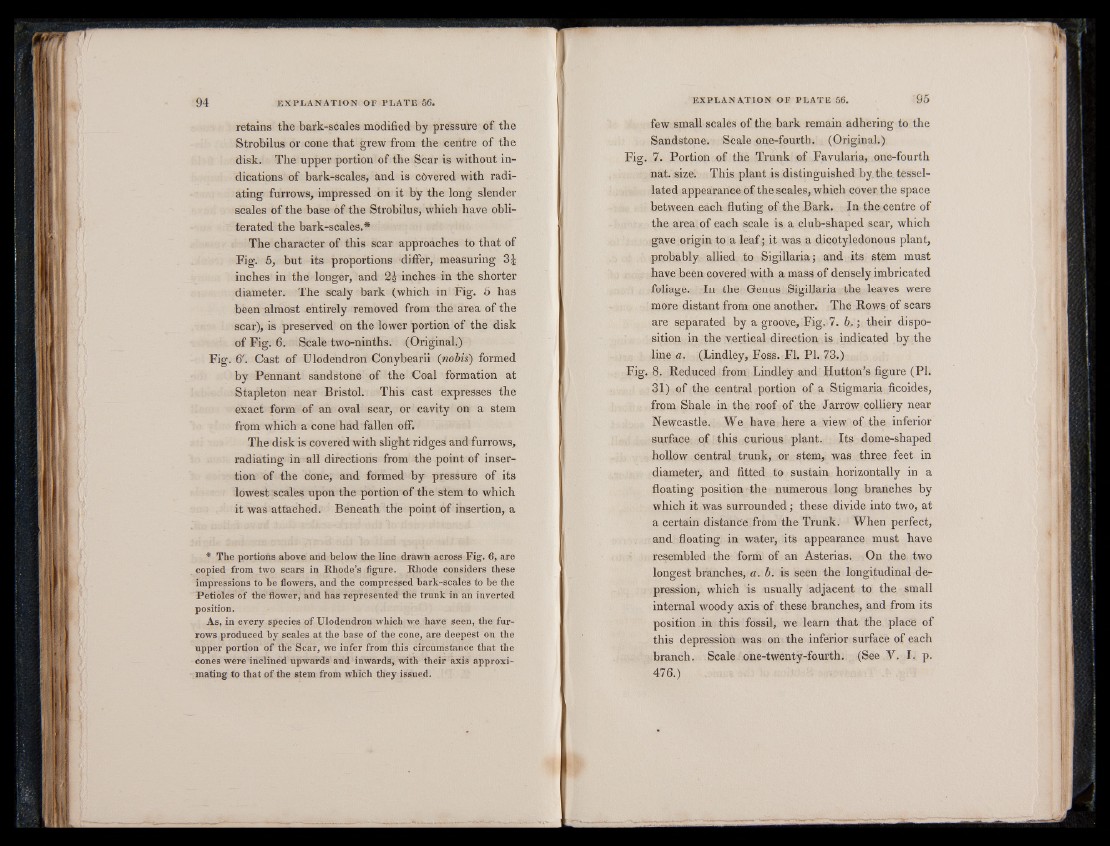
retains the bark-scales modified by pressure of the
Strobilus or cone that grew from the centre of the
disk. The upper portion of the Scar is without indications
of bark-scales, and is c&vered with radiating
furrows, impressed on it by the long slender
scales of the base of the Strobilus, which have obliterated
the bark-scales.*
The character of this scar approaches to that of
Fig. 5, but its proportions differ, measuring 3*
inches in the longer, and 2J inches in the shorter
diameter. The scaly bark (which in Fig. 5 has
been almost entirely removed from the area of the
scar), is preserved on the lower portion of the disk
of Fig. 6. Scale two-ninths. (Original.)
Fig. 6'. Cast of Ulodendron Conybearii (nobis) formed
by Pennant sandstone of the Coal formation at
Stapleton near Bristol. This cast expresses the
exact form of an oval scar, or cavity on a stem
from which a cone had fallen off.
The disk is covered with slight ridges and furrows,
radiating in all directions from the point of insertion
of the cone, and formed by pressure of its
lowest scales upon the portion of the stem to which
it was attached. Beneath the point of insertion, a
* The portions above and below the line drawn across Fig. 6, are
copied from two scars in Rhode’s figure. Rhode considers these
impressions to he flowers, and the compressed bark-scales to he the
Petioles of the flower, and has represented the trunk in an inverted
position.
As, in every species of Ulodendron which we have seen, the furrows
produced by scales at the base of the cone, are deepest on the
upper portion of the Scar, we infer from this circumstance that the
cones were inclined upwards and inwards, with their axis approximating
to that of the stem from which they issued.
few small scales of the bark remain adhering to the
Sandstone. Scale one-fourth. (Original.)
Fig. 7. Portion of the Trunk of Favularia, one-fourth
nat. size. This plant is distinguished by the tessellated
appearance of the scales, which cover the space
between each fluting of the Bark. In the centre of
the area of each scale is a club-shaped scar, which
gave origin to a leaf; it was a dicotyledonous plant,
probably allied to Sigillaria; and its stem must
have been covered with a mass of densely imbricated
foliage. In the Genus Sigillaria the leaves were
more distant from one another. The Rows of scars
are separated by a groove, Fig. 7. b ,; their disposition
in the vertical direction is indicated by the
line a. (Lindley, Foss. FI. PI. 73.)
Fig. 8. Reduced from Lindley and Hutton’s figure (PI.
31) of the central portion of a Stigmaria ficoides,
from Shale in the roof of the Jarrow colliery near
Newcastle. We have here a view of the inferior
surface of this curious plant. Its dome-shaped
hollow Central trunk, or stem, was three feet in
diameter, and fitted to sustain horizontally in a
floating position the numerous long branches by
which it was surrounded; these divide into two, at
a certain distance from the Trunk. When perfect,
and floating in water, its appearance must have
resembled the form of an Asterias. On the two
longest branches, a. b. is seen the longitudinal depression,
which is usually adjacent to the small
internal woody axis of these branches, and from its
position in this fossil, we learn that the place of
this depression was on the inferior surface of each
branch. Scale one-twenty-fourth. (See V. I. p.
476.)